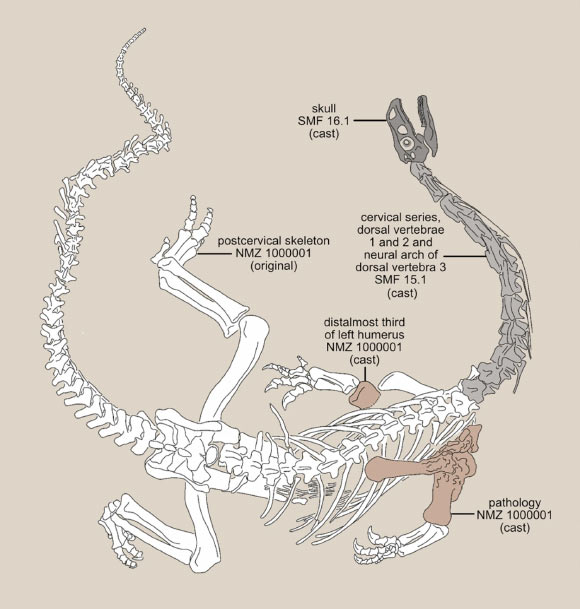A ream of paleontologists at the University of Zurich reports a chronic case of osteomyelitis (bone tissue infection) in Plateosaurus trossingensis, one of the earliest discovered and best-known dinosaurs from the Late Triassic of Europe.
Diagram of the Plateosaurus trossingensis skeleton as part of the Teoplati exhibit at the Natural History Museum of the University of Zurich. Image credit: Dupuis et al., doi: 10.1186/s13358-025-00368-3.
Plateosaurus trossingensis lived in Europe during the Late Triassic epoch, some 220 million years ago.
The ancient animal was nearly 8 m (26 feet) long and walked on its two hind limbs.
In new research, University of Zurich paleontologist Jordan Bestwick and colleagues examined a skeleton of Plateosaurus trossingensis from the Klettgau Formation of Frick, Switzerland.
They found evidence for severe osteomyelitis in the dinosaur’s right shoulder and upper arm.
“Osteomyelitis affects many living animals, including mammals such as humans, as well as birds and reptiles,” Dr. Bestwick said.
“This disease is known to have affected several different dinosaur groups, including sauropods, so we had access to a range of specimens to compare our Plateosaurus with.”
“The affected bones in the shoulder and upper arm have unusually rough internal and external textures, altered shapes, and are even fused together — symptoms that are broadly typical of osteomyelitis.”
According to the researchers, their discovery is fascinating not only because, at around 220 million years old, it is the currently oldest reported case of osteomyelitis in a dinosaur, but the size of the infected area was unusually large.
“Previous studies of osteomyelitis in dinosaurs report localized areas of infection, such as toe bones or a couple of adjacent bones in the spine,” Dr. Bestwick said.
“Having an entire infected shoulder and upper arm is very unusual.”
“Although we don’t know what initially caused the infection, the animal likely suffered from this disease for a substantial part of its life, possible rendering its right arm useless.”
The discovery is reported in a paper published in the Swiss Journal of Palaeontology.
_____
S.F.J. Dupuis et al. 2025. Osteology and histology of a Plateosaurus trossingensis (Dinosauria: Sauropodomorpha) from the Upper Triassic of Switzerland with an advanced chronic pathology. Swiss J Palaeontol 144, 27; doi: 10.1186/s13358-025-00368-3

























